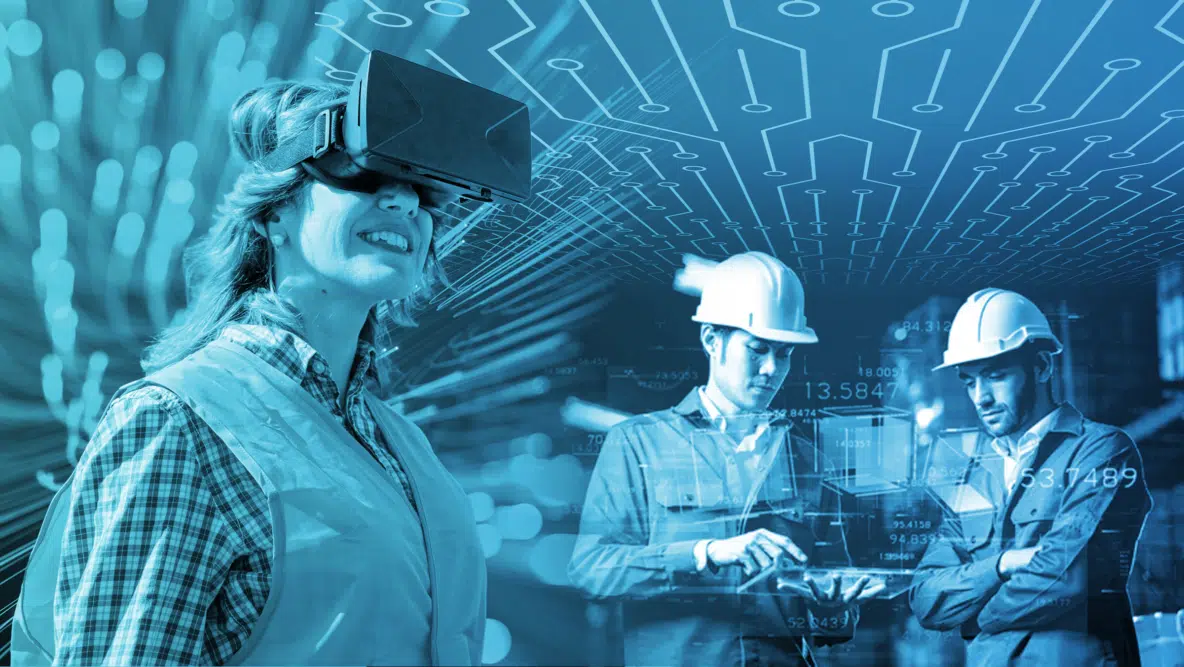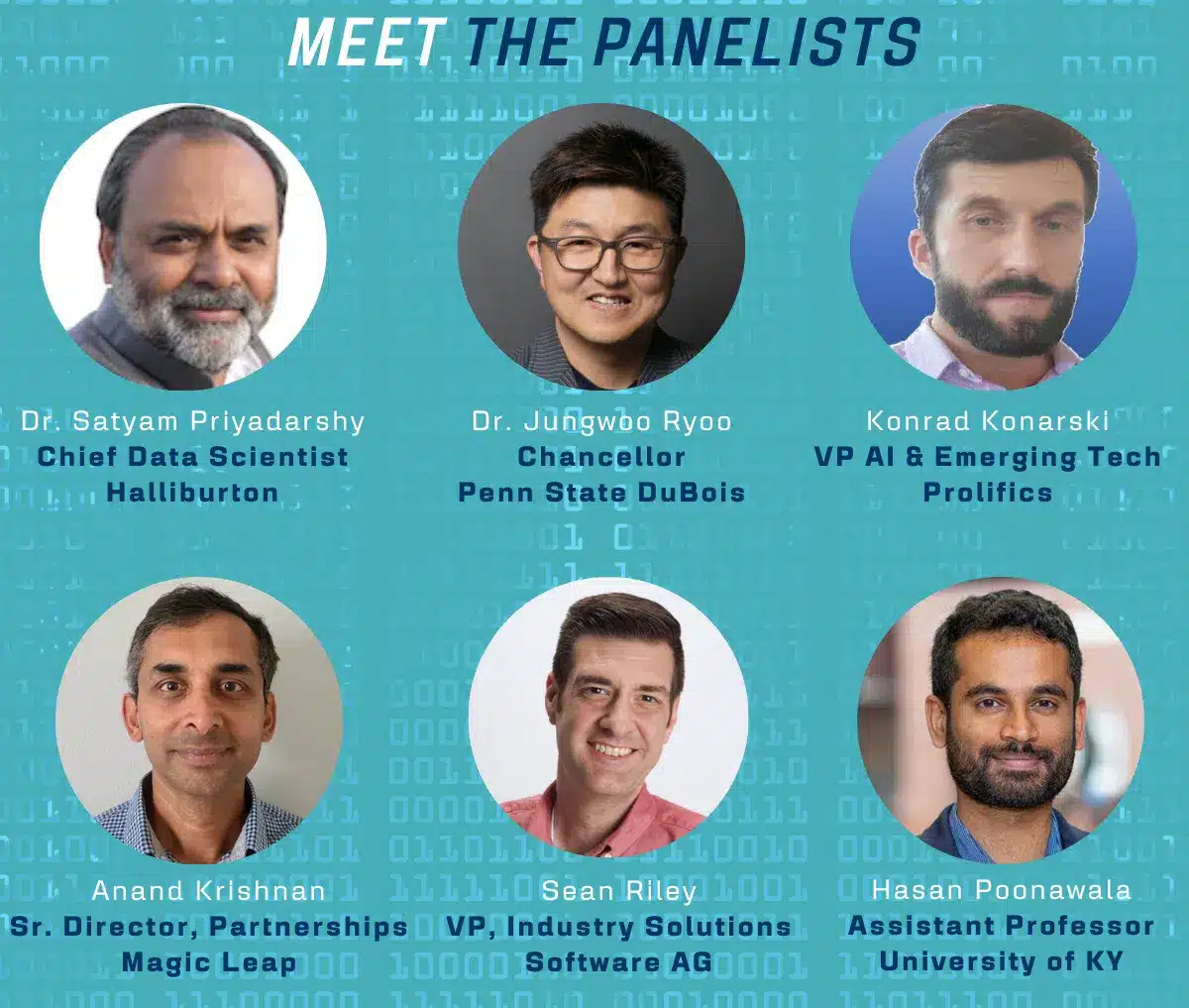Panelist Q&A: The Factory Floor that Tells You More
July 5, 2023

Uncover the exciting fusion of Industrial Metaverse, Augmented Reality, and Artificial Intelligence as six diverse industry leaders engage in a dynamic virtual discussion. Explore the possibilities, discover real-world use cases, tackle challenges, and find out how to overcome them. Don’t miss out on this engaging conversation that sheds light on the intersection of these transformative technologies!
“The true value of AI lies in augmenting tasks, empowering workers, and enhancing capabilities. Technologies like GPT, AI computer vision, and mixed reality provide valuable support in analyzing data and text, improving worker performance. By embracing reinvention and aligning with future technologies, we navigate the industrial revolution successfully.”
Konrad Konarski
What does AI, Industrial Metaverse and Augmented Reality Technology mean to you?
Konrad
- Generative AI: Technology like ChatGPT which learns and structures information like the human brain. It represents the state-of-the-art in statistics and is at the forefront of artificial intelligence, mixed reality, and augmented reality.
Hasan:
- Decision-Making: Whether it’s strategizing process control actions or responding to robot operations and repairs, mixed reality and the metaverse play a crucial role. By simulating processes and utilizing real-time information from physical systems, the metaverse enhances decision-making and serves as a valuable tool in augmenting operational processes.
Dr. Jungwoo:
- The Synergy of Mixed Reality (AR) and AI: In its simplest form, AR and AI are intertwined. For instance, AI is employed in gesture control and other device interactions. Moreover, our partners and customers extensively utilize AI in various applications, such as conversational AI and environmental mapping for object and image recognition.
Sean:
- Predictive Analytics, Machine Learning, and Mixed Reality: These fields utilize predictive models to address complex issues that are often too challenging for quick and accurate human decision-making. For instance, on a shop floor, understanding product quality and machine stoppages requires more than simple operator actions. Algorithms can offer valuable insights and alternative approaches. Mixed reality, on the other hand, acts as a leveling technology by supporting less experienced field technicians with augmented reality, tapping into the knowledge of seasoned professionals to handle complex problems.
“The integration of AI and mixed reality technologies empowers workers by aggregating and presenting relevant information to support them in complex tasks. By connecting external data sources and utilizing generative AI, these technologies enhance the capabilities of connected workers and provide valuable assistance through mixed reality experiences.”
Konrad Konarski
What industries and use cases do you observe as actively adopting these technologies?
Industrial Manufacturing: The panelists unanimously agree that Industrial Manufacturing exemplifies the significant impact of these technologies on enhancing performance, productivity, and cost-effectiveness.
Augmented reality plays a vital role in guiding workers through complex tasks, providing training, and improving maintenance and repair processes. By delivering step-by-step instructions through mixed reality, it reduces equipment downtime and improves first-time fixed rates.
The Manufacturing Industry also recognizes the importance of utilizing AI and mixed reality for seamless die setter training, promoting workforce development. Real-time process control and predictive modeling further optimize manufacturing processes, leading to reduced scrap rates and substantial productivity gains. The integration of mixed reality and predictive modeling drives industry advancements and maximizes operational efficiency.
Other Noteworthy Industry Use Cases:
- Medical Field: The medical field presents a wide range of use cases, spanning from advanced medical imaging to comprehensive physician training and even vital surgical assistance.
- Architecture, Engineering, and Construction (AEC): The AEC verticals leverage augmented reality to overlay models, minimizing errors and optimizing construction processes.
- Automotive Industry: The automotive industry utilizes AI and mixed reality to enhance their assembly process and improve product quality. Real-time sensor data analysis and predictive analytics enable quick issue identification and maintenance prediction, leading to high repair rates and optimized resource usage. They also leverage mixed reality and digital twin technology for research and development, driving improvements in efficiency.
- Energy and Utilities (EU) Industry: The EU industry embraces augmented reality integration in remote fields, delivering real-time field insights and enabling remote control and advisory capabilities from headquarters. This integration significantly reduces downtime in field operations while unlocking transformative potential beyond training and simulation.
“We can harness the power of AI technology and unlock valuable insights that were previously untapped. By doing so, we can efficiently extract intuitive domain expert knowledge using artificial intelligence engines, resulting in cost-effective solutions.”
konrad konarski
What are the obstacles to adopting technology and how can they be overcome?
“When it comes to barriers, it’s not just about assembling multidisciplinary teams; we also need individuals with diverse skill sets.”
Hasan poonawala
Obstacles
- Outdated Machinery: The hindrance caused by machines lacking real-time data extraction capabilities poses a challenge to implementing advanced technologies.
- Large-Scale Deployment: Transitioning from pilot projects to widespread deployment requires integration into existing business processes, presenting a hurdle to overcome.
- Poor Data Quality: Inconsistencies and challenges related to data normalization hinder the development of reliable predictive algorithms.
- Research and Data Collection: This includes issues such as limited availability of data, data quality concerns, ethical considerations, privacy concerns, obtaining consent, and ensuring the data collected is representative and reliable.
Overcoming these challenges involves streamlining data normalization, implementing resilient processes, and prioritizing security education and preventive measures.
- Process Assesment and Model Updates: Mixed reality can facilitate experts in visually and audibly assessing processes to identify defects and provide valuable input for model updates.
- Security and Authentication: Addressing authentication concerns for both AR and enterprise applications is essential as technology convergence and data silos are eliminated.
- Well-Defined Processes: Expanding AI programs necessitates a well-defined and adaptable process for handling data sourcing, deployment, and algorithm adaptation.
- Leadership Approach to Technology Implementation: A comprehensive integration of AR/VR solutions into a digital twin ecosystem, driven by multidisciplinary teams comprising data scientists, AR/VR experts, and domain specialists, is crucial for uncovering true value.
- Customizable Software Solutions: Accessible and customizable software solutions designed specifically for mixed realities and artificial intelligence can streamline processes and enable effective utilization of these technologies.
Summary
To unlock the full potential of AR, VR, and mixed reality, it is essential to harness the capabilities of advanced artificial intelligence techniques. By optimizing prescriptive models and fully utilizing expansive data sets, businesses can propel themselves forward. Embracing new avenues of AI allows organizations to overcome obstacles and gain a comprehensive understanding of crucial data, empowering them to make informed decisions. These powerful tools are not only reshaping industries but also driving significant advancements in fields such as Industrial Manufacturing, the Medical Field, AEC, Automotive Industry, EU Industry, and more. By embracing these technologies and surmounting the challenges of adoption, organizations can tap into valuable insights, enhance performance, and pave the way for a successful future
